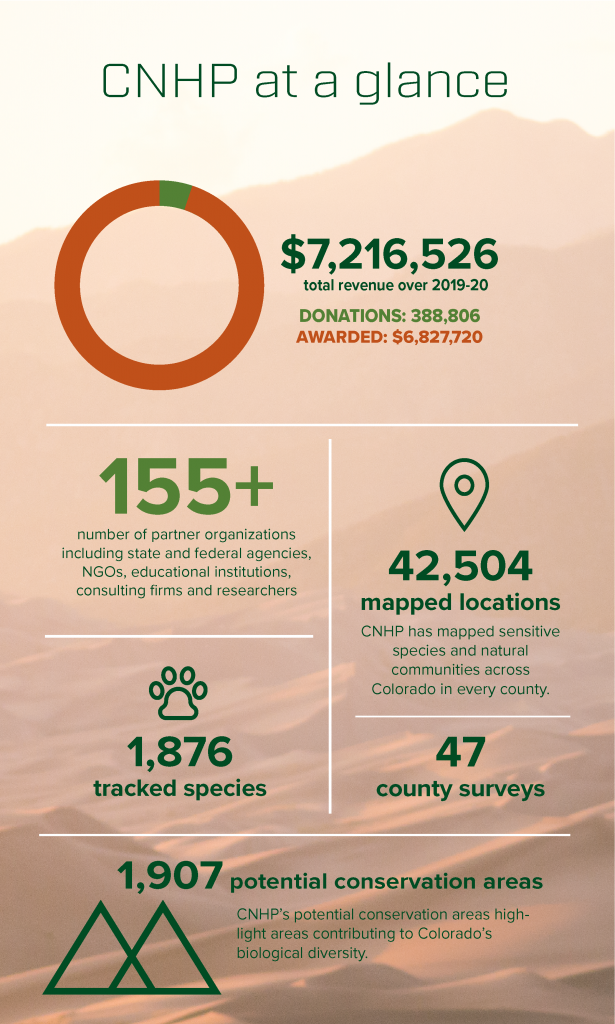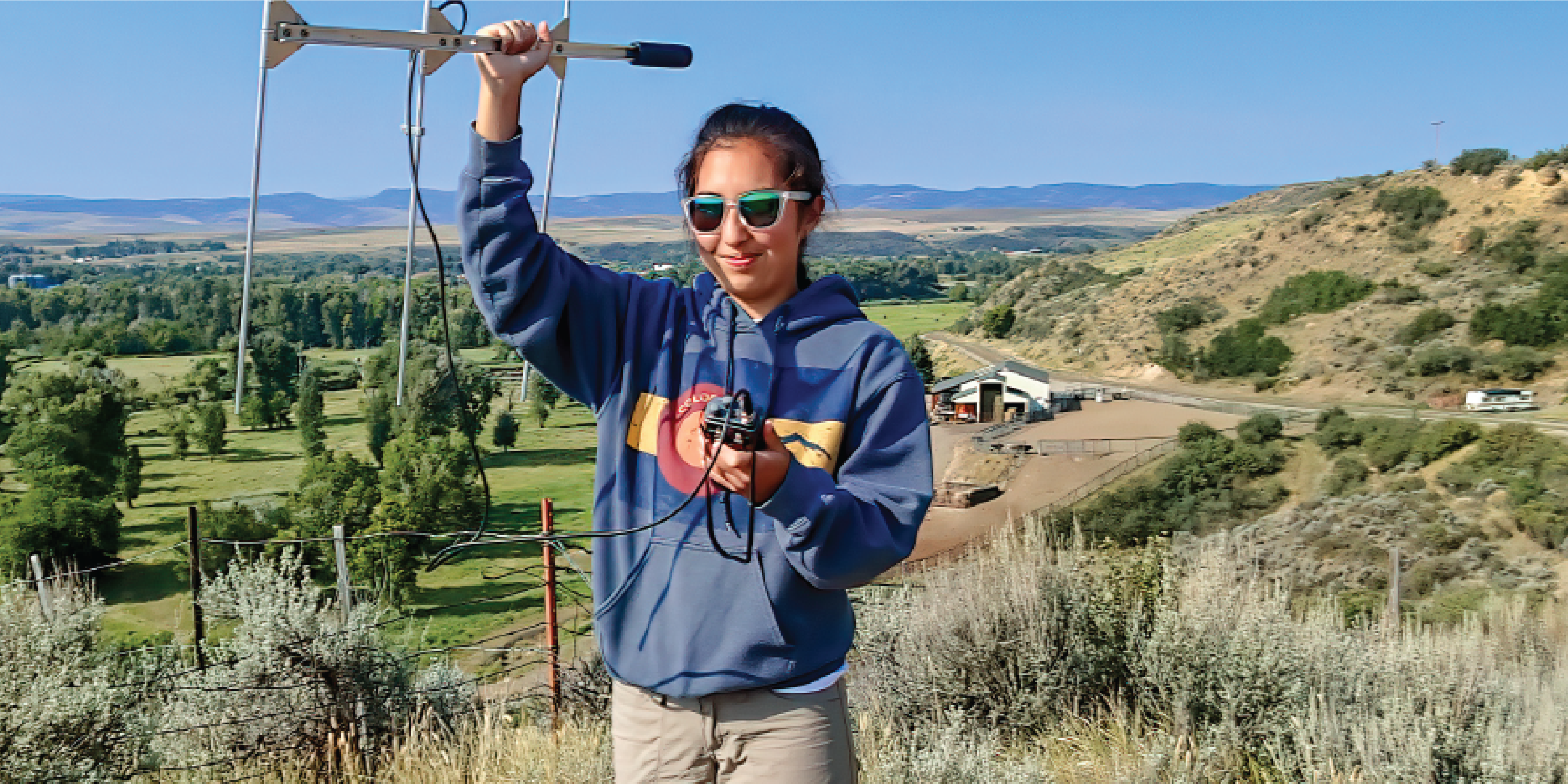From the Director
Dear Friends,
The last two years have been a collection of momentous events in Colorado. We added a new state park, Fisher’s Peak, a glorious crowning jewel of the state park system, that came about through a broad and diverse partnership. The Colorado Oil and Gas Conservation Commission (COGCC) has written guidelines for conserving land and wildlife as part of their new mission. Legislation was passed in Colorado to support the continuation of the tax credits and Colorado’s protected areas map (COMaP) that turbo charge conservation easements and our amazing community of land trusts. The Nature Conservancy completed their map of the Resilient and Connected Network of the United States, guiding climate-smart conservation. Through these great moments we also had our three largest fires in Colorado history, one of two warmest years on record, and of course a pandemic. The last time that many of us got to see each other was at CNHP’s Partners Meeting on March 10, 2020! I am so grateful that we got to finish that event with you right before everything shut down.
Writing to you now, we are under air quality alerts caused by smoke from California fires. This time last year, the same thing happened with smoke from Colorado fires. Maybe we have crossed a tipping point into a new normal now. Finding solutions to the big conservation challenges that we face now is urgent, and those solutions will be collaborative. Successfully averting the worst forecasts for climate change will only happen when we collaboratively make the right decisions based on science and data. The conserved landscape of Colorado and the rest of the world needs to grow a lot as part of that. That growth needs to be planned carefully to maximize the carbon sequestration and biodiversity impact of the enlarged conservation portfolio. Private lands are a critical part of that success, and we are thrilled about innovations to help our private land conservation partners. Lands that provide access to nature for disadvantaged communities are also a critical part of that success, as are tribal and public lands and the way that they are managed. CNHP is ready to support the planning we will do in Colorado to move forward into a sustainable and equitable future.
Towards our efforts to support that future, we have spent much of the last two years on the path to launching the Colorado Conservation Data Explorer (CODEX). CODEX is transforming the way that Coloradoans make decisions. Partnering with Colorado Parks and Wildlife, The Nature Conservancy, Bird Conservancy of the Rockies, History Colorado, and others, we are bringing the key data together for conservation decision making into one place. Coloradoans will find it easy to access decision quality spatial data using CODEX. And we will do so with the assurance that we are using the most current and relevant data. This is the culmination of the goals of CNHP and our partners to collaboratively guide conservation with data and science.
Our conservation needs and challenges are formidable, but our work with you has shown us that you have the resolve, vision, and drive to meet them. The payoffs to our success are beyond measure. CNHP is here to support the entire conservation community as we walk forward together.
We hope you enjoy reading about our recent program highlights in this biennial report.

David G. Anderson
Director and Chief Scientist


Project Highlights
Bat Monitoring
Bat Monitoring
Bat Monitoring
Bats are increasingly threatened across North America. CNHP is working with state and federal agencies, private citizens, and recreationists to address survey and monitoring needs of bats in Colorado. We are involved in population surveys, roost monitoring, acoustic monitoring and data processing, and Colorado’s implementation of the North American Bat Monitoring Program. CNHP is working with state and federal agencies, private citizens, and recreationists to address survey and monitoring needs of increasingly threatened bats in Colorado.
BLM Assessment Inventory and Monitoring
BLM Assessment Inventory and Monitoring
BLM Assessment Inventory and Monitoring
The Bureau of Land Management (BLM) developed the Assessment, Inventory, and Monitoring (AIM) Strategy to standardize monitoring of natural resource condition and trend on BLM public lands. The AIM Strategy provides quantitative data and tools to guide and justify policy actions, land uses, and adaptive management decisions. The Bureau of Land Management (BLM) developed the Assessment, Inventory, and Monitoring (AIM) Strategy to standardize monitoring of natural resource condition and trend on BLM public lands.
Fishers Peak State Park Biological Survey
Fishers Peak State Park Biological Survey
Fishers Peak State Park Biological Survey
Fishers Peak State Park opened to the public on October 30, 2020. CNHP, in collaboration with partners, conducted biological surveys to document the biodiversity, sensitive natural heritage resources, and most important areas for conservation at the park. Fishers Peak State Park, southeast of the town of Trinidad, opened to the public on October 30, 2020. It is home to Fishers Peak at 9,633 feet (2,936 m), the highest point east of its longitude in the United States.
Internships
Internships
Internships
Our home at CSU makes it easy for us to bring student interns into our collaborative, multi-source funded projects. Students learn skills, build resumes, network, and find success under the guidance of our passionate staff mentors. Through the vision and generosity of our donors, we are able to host student internship programs. Our home at CSU makes it easy for us to bring student interns into our collaborative, multi-source funded projects.
Rare Plant Monitoring
Rare Plant Monitoring
Rare Plant Monitoring
CNHP is partnering with several state and federal agencies to conduct long-term population trend monitoring for Chapin Mesa milkvetch, Parachute penstemon and Pagosa skyrocket to meet conservation goals for these rare species. CNHP is partnering with several state and federal agencies to conduct long-term population trend monitoring for Chapin Mesa milkvetch, Parachute penstemon and Pagosa skyrocket to meet conservation goals for these rare species.
Roaring Fork Study
Roaring Fork Study
Roaring Fork Study
This study was a collaborative investigation into the status of biodiversity values and landscape connectivity across the Roaring Fork watershed. Objectives include understanding habitat quality and the highest priority areas for conservation and restoration for focal species and their habitats. This study was a collaborative investigation into the status of biodiversity values and landscape connectivity across the Roaring Fork watershed.
Photo Credits:
Top photo (columbine watching over Mount Bellview): Andrea Schuhmann; Project highlights clockwise from left: Jeremy Siemers, Vinny Del Conte, Torrey Davis, Schuhmann,Andrea, Jill Handwerk, Vincent Del Conte; Bottom photo (Kira Paik, a recent CSU graduate and former Siegele intern): Toryn Walton




